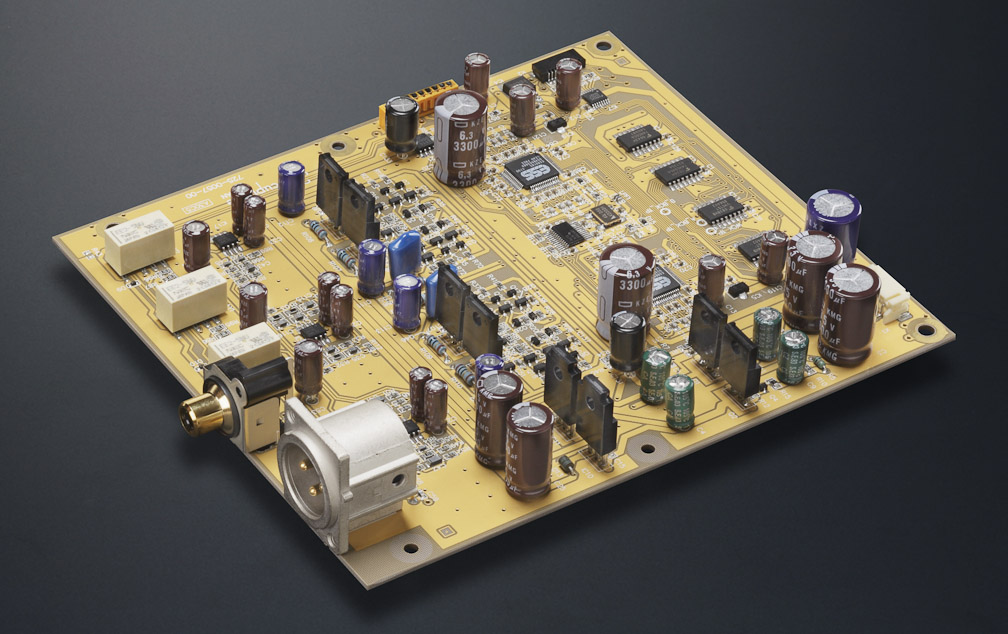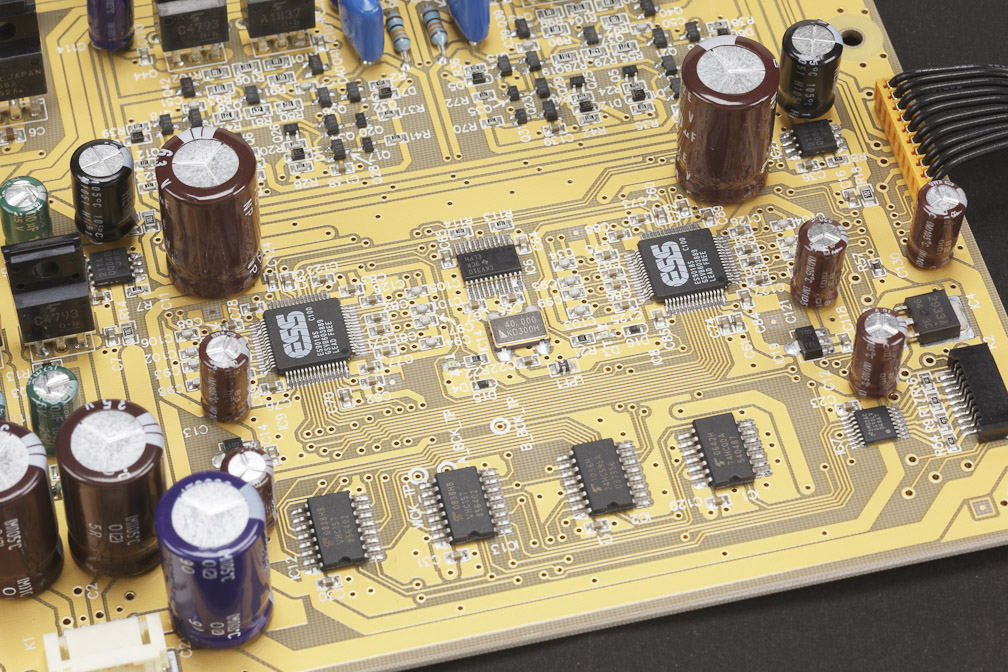... I have been able to do the same via XMOS for quite a while now. ... I have also experimented with generating the bit clock and word clock by dividing the master clock. Which worked well, but requires two master clocks.
Oh, you have already achieved a stable play of 384 kHz/32 bit sources with OSF=ON, Jitter Reduction=ON, DPLL BW ="the lowest" on your Buffalo II/80 MHz/100 MHz. It's great!
Is the XMOS-based USB interface capable of seamless play of 44.1 kHz to 384 kHz without changing its wiring or configuration?
Anyway, I've been actually waiting for your X-MOS product for more than one year without buying other similar kits.
I really hope your superior product is realized immediately and many people can reproduce the sound you already have and enjoy it.
By the way, Chiaki's approach is one master clock for one sampling frequency series approach.
By the way, Chiaki's approach is one master clock for one sampling frequency series approach.
So you mean he is only using 48khz multiples?
One oscillator is employed for 44.1 kHz series and another for 48 kHz series.So you mean he is only using 48khz multiples?
Totally two oscillators. Nothing more. Is it the same configuration to yours?
Yes. Then using the selected clock to generate the clocks for PCM.
In this case you would not use the 80 or 100Mhz clocks on the Buffalo.
The reason this works is because the DPLL is basically doing nothing now, or rather it can't help but be in synch 🙂
In this case you would not use the 80 or 100Mhz clocks on the Buffalo.
The reason this works is because the DPLL is basically doing nothing now, or rather it can't help but be in synch 🙂
... or rather it can't help but be in synch 🙂
I think we can call it as a "synchronous mode".
When a transport can send I2S signals of high quality enough , the mode may yield better results.
ATTiny85
Hello Russ
Does that use an external crystal clock.
May I ask why you left microchip micros.
Regards
Arthur
Hello Bumpie
You mention "Copper foil & Polyphenylene Sulfide(PPS) Film Capacitor" can I ask you what is the brand of this part and are they still available.
Regards
Arthur
You mention "Copper foil & Polyphenylene Sulfide(PPS) Film Capacitor" can I ask you what is the brand of this part and are they still available.
Regards
Arthur
Does anyone try any synchronous configuration of I2S for ES9018, with such lower MCLK frequency range as 11. 2896 MHz, or 22.5792 MHz for fs=44.1 kHz source?
I just tried 22.5792 MHz synchronous MCLK input to master clock XI pin of ES9018 and found it feasible enough for from fs=44.1 kHz to fs=352.8 kHz sources under OSF = OFF conditions.
I just tried 22.5792 MHz synchronous MCLK input to master clock XI pin of ES9018 and found it feasible enough for from fs=44.1 kHz to fs=352.8 kHz sources under OSF = OFF conditions.
Hi, Bunpei
I' ve just tried feeding 11.2896mhz to BuffaloII directly from QA-550's XO pin after reading your post. It works very well 😎
I found it gives better soundstage and 3D imaging. Quite enjoyable although it can play only 16bit/44.1khz wav files.
I' ve just tried feeding 11.2896mhz to BuffaloII directly from QA-550's XO pin after reading your post. It works very well 😎
I found it gives better soundstage and 3D imaging. Quite enjoyable although it can play only 16bit/44.1khz wav files.
small update on QA-550/Buffalo II syncronous combo
According to the ES9018's datasheet, IF you only play 16bit/44.1khz files, 11.2896mhz is enough for
OSF mode. I had tried it after previous post and the result was much better than bypassing OSF.
Now Mid and Hi are much cleaner and more opened, and more "natural" in addition to detailed/better difined sound
According to the ES9018's datasheet, IF you only play 16bit/44.1khz files, 11.2896mhz is enough for
OSF mode. I had tried it after previous post and the result was much better than bypassing OSF.
Now Mid and Hi are much cleaner and more opened, and more "natural" in addition to detailed/better difined sound
Last edited:
Hi, wktk_smile,
Thank you very much for your replies to my question!
Yes, you are correct. As far as a master clock frequency > 192 fs, OSF mode can be ON.
Have you already tried, 90.3168 MHz(44.1 kHz x 2048) or 98.3040 MHz(48 kHz x 2048) synchronous master clock of SDTrans384 with your Buffalo II?
Bunpei
Thank you very much for your replies to my question!
Yes, you are correct. As far as a master clock frequency > 192 fs, OSF mode can be ON.
Have you already tried, 90.3168 MHz(44.1 kHz x 2048) or 98.3040 MHz(48 kHz x 2048) synchronous master clock of SDTrans384 with your Buffalo II?
Bunpei
Yep, I received EEPROM for synchronous ES9018 from Chiaki san.
It's really astonishing. I will report to "MicroSD memory card Transport Project" thread.
It's really astonishing. I will report to "MicroSD memory card Transport Project" thread.
ES9018 chips in Accuphase DC-901
Close-up photos are shown on the site;
Wizard High-End Audio Blog: More pictures of Accuphase DC-901
Two ES9018 chips per channel, 16 DAC modules for one channel!


One 40MHz master clock oscillator per channel.
Close-up photos are shown on the site;
Wizard High-End Audio Blog: More pictures of Accuphase DC-901
Two ES9018 chips per channel, 16 DAC modules for one channel!


One 40MHz master clock oscillator per channel.
An ES9018-based DAC, CAPRICE by Fidelix is bringing up a mood of reappraisal of DSD sounds in Japan. The DAC offers an option of raw DSD signal input and I heard that at least two famous audio reviewers in Japan purchased CAPRICE with the option.
According to Functional Block Diagram in Product Brief document of ES9018, it seems for me that DSD signals are converted into PCM at the stage prior to oversampling in ES9018. This approach seems quite different from such DAC chips, TI DSD1702 or DSD1608 that has a dedicated DSD filtering signal path.
How do you feel about this point?
Hi, I think I read that 9018 DSD is not converted to PCM in this thread. Can anyone confirm that DSD signal is not converted internally in ESS 9018 ?
Best
Good news to those who wanted to see the ES9018 DAC datasheet!
I spoke with Bryan at Shaw Electronics (shawelectronics.com), the US distributor for the chip... he said that 6 months ago the ES9018 datasheet was taken off the non-disclosure agreement list, so now you just have to request it and he will send it to you.
So, if you want the ES9018 DAC datasheet, kindly email Bryan at "bryan at shawelectronics dot com" and ask! 🙂
I spoke with Bryan at Shaw Electronics (shawelectronics.com), the US distributor for the chip... he said that 6 months ago the ES9018 datasheet was taken off the non-disclosure agreement list, so now you just have to request it and he will send it to you.
So, if you want the ES9018 DAC datasheet, kindly email Bryan at "bryan at shawelectronics dot com" and ask! 🙂
- Home
- Source & Line
- Digital Line Level
- ESS Sabre Reference DAC (8-channel)